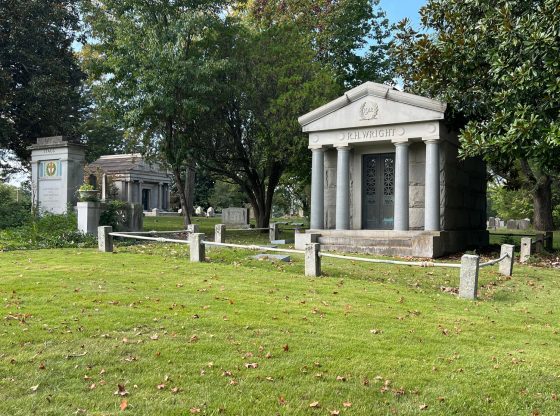The North Carolina Department of Natural and Cultural Resources recently announced that three historic districts and twelve individual properties across the state have been added to the National Register of Historic Places. The following properties were reviewed by the North Carolina National Register Advisory Committee and subsequently nominated by the North Carolina State Historic Preservation Officer and forwarded to the Keeper of the National Register for consideration for listing in the National Register.
“Preserving our history is vital to understanding who we are and shaping where we’re headed,” said Reid Wilson, secretary of the N.C. Department of Natural and Cultural Resources. “The newest additions from North Carolina to the National Register of Historic Places demonstrate our commitment to safeguarding our heritage, enriching our shared story, and strengthening local economies.”
The listing of a property in the National Register places no obligation or restriction on a private owner using private resources to maintain or alter the property. Over the years, various federal and state incentives have been introduced to assist private preservation initiatives, including tax credits for the rehabilitation of National Register properties. As of Jan. 1, 2024, there have been 4,308 historic rehabilitation projects with private investments of almost $3.6 billion completed.
In Central North Carolina
Copland Fabrics, Burlington, Alamance County, listed 8/1/2024
Copland Fabrics is significant at the local level and listed in the National Register of Historic Places under Criterion A in the area of Industry. Alamance County was a locus of fabric production, starting with water-powered mills along the Haw River in the nineteenth century. The extant buildings reflect industrial architecture of the nineteenth and twentieth centuries and the changes in production of textiles. Copland Fabrics and its CEO, J.R. Copland, shifted production here to rayon in 1941. Innovations in techniques and machinery developed and implemented at this facility allowed Copland Fabrics to produce good-quality rayon economically. Additional expansion to fabric finishing gave the conglomerated Copland companies vertical integration as well as fee-based services to other mills. The mill buildings show the evolution of fabric production from the late nineteenth to the late twentieth century in a county noted for its leadership in textiles. The complex has a period of significance from 1941, the date of the purchase of the complex by the Coplands, to 1973, the date of the last plant expansion that is over 50 years of age.
Geer Cemetery, Durham, Durham County, listed 8/5/2024
Geer Cemetery is significant at the local level under Criterion A in the areas of Social History and Black Ethnic Heritage as the oldest extant community burial ground for African Americans in Durham. It contains an estimated 1,825 graves densely organized in north – south rows with the graves oriented east – west. The ephemeral nature of wood grave markers, which were used extensively in the late nineteenth and early twentieth centuries and were documented in period newspaper articles at Geer Cemetery, has left many graves unmarked today. Extant marker types include tab-in-socket and die-on-base headstones, pedestal tombs, and obelisks. Geer Cemetery’s period of significance begins in 1877, the year in which the Board of Trustees acquired the first two acres of land from white farmer Jesse Geer for use as a community cemetery for Durham’s people of color. It ended in 1945 when the last burial occurred in the cemetery. Geer Cemetery meets National Register Criteria Consideration D for cemeteries as its significance is derived from its historic associations under Criterion A.
One Center Plaza, High Point, Guilford County, listed 4/10/2024
One Plaza Center is listed in the National Register of Historic Places at the local level of significance under Criterion A in the area of Community Planning and Development and under Criterion C in the area of Architecture. During the mid-twentieth century, the City of High Point and the High Point Redevelopment Commission (HPRC) carried out an urban renewal program that reshaped the city. One Plaza Center is one of the few remaining mid-twentieth-century office buildings in downtown High Point. The resulting Brutalist-style office building, designed by prominent North Carolina architect James Norman Pease, Jr., is an integral piece of the fabric of downtown High Point and served as the physical and visual center of the mid-twentieth century commercial district. Its development and construction represent the effective use of Urban Renewal funds and served as an impetus to a broader shift in community planning and development in High Point. One Plaza Center’s period of significance began in 1970, when construction on the building commenced through 1974, when construction was completed, and tenants began moving into the building.
R.J. Reynolds Tobacco Company Buildings 82 and 83, Winston-Salem, Forsyth County, listed 8/7/2024
R.J. Reynolds Tobacco Company Buildings 82 and 83, erected in 1919 to provide tobacco leaf storage, are in the National Register of Historic Places listed under Criterion A due to their local industrial significance. The company fueled Winston-Salem’s economic prosperity as the concern grew to become the nation’s largest tobacco manufacturer in 1922. Due to spatial constraints at its downtown plant, RJRTC steadily acquired acreage in north Winston-Salem in proximity to the railroad corridor. Buildings 82 and 83 are the earliest identified extant tobacco storage warehouses in the city constructed per standard RJRTC specifications. Original features include large skylights and twelve-over-twelve double-hung wood windows that provide ample light and ventilation, sliding metal-clad and flat-panel metal doors at most entrances, and the concrete loading platform that spans Building 83’s west elevation. The period of significance began in 1919 with the buildings’ construction and continued until 1973. Although RJRTC owned the warehouses until 1992, their function after 1973 is not of exceptional significance.
Sidney Cotton Mill, Graham, Alamance County, listed 8/2/2024
The Sidney Cotton Mill is listed in the National Register under Criterion C as a largely intact example of late-nineteenth and early-twentieth-century, Italianate-style industrial architecture and slow-burn industrial construction. Developed in the late nineteenth century and codified by insurance companies, slow-burn construction was developed as a cost-effective means of protecting textile mills from loss due to fire. The Sidney Cotton Mill was among the earliest steam-powered mills to be constructed in Alamance County and was only the second steam-powered mill, of at least five mills in total, to be constructed within the town of Graham. The architecture of the Sidney Cotton Mill is typical of turn-of-the-twentieth-century textile mills constructed in the North Carolina Piedmont; it features Italianate-style detailing, including segmental-arch window openings and corbelled brick cornices, as well as intact, three-story tower on the south elevation. The period of significance extends from 1886, the date of the earliest part of the mill, to ca. 1945 to incorporate its last addition.
Warrenton Historic District (Additional Documentation, Boundary Increase, and Boundary Decrease), Warrenton, Warren County, listed 4/4/2024
The nomination provides Additional Documentation for the 1976 Warrenton Historic District, a Boundary Increase to include early-to-mid-twentieth century buildings and African American resources, and a Boundary Decrease to remove vacant lots, recent construction, and substantially altered properties on the periphery of the Historic District. Additional Documentation for the Warrenton Historic District includes an updated inventory for the district with full written descriptions and a contributing status given for all resources within the district boundary. It clarifies the beginning of the period of significance for the Warrenton Historic District to begin c. 1783, corresponding with the construction of the Peter Davis Store, the earliest extant aboveground resource, and extends the end of the period of significance to extend to 1971 to include Warrenton’s period of racial conflict related to the Civil Rights Movement and integration of the schools. The Additional Documentation also clarifies the areas of significance for the Warrenton Historic District.
West End Cemeteries Historic District, Durham, Durham County, listed 8/6/2024
The West End Cemeteries Historic District is a collection of four contiguous cemeteries across 26 acres in the historically residential and primarily African American West End neighborhood. Consisting of the 23.71-acre Maplewood Cemetery, 0.9-acre Hebrew Cemetery, 1.14-acre Henderson Family Cemetery, and 0.25-acre Fitzgerald Family Cemetery, the historic district contains a wide range of burial and marker types illustrative of the socio-economic backgrounds of the groups it represents. The West End Cemeteries Historic District is listed in the National Register of Historic Places at the local level under Criteria A and C. The Henderson and Fitzgerald family cemeteries are significant under Criterion A in the areas of Social History and Black Ethnic Heritage, the Hebrew Cemetery is significant under Criterion A in the areas of Social History and Jewish Ethnic Heritage, and the Maplewood cemetery is significant under Criterion C in the area of Art for its distinctive collection of mausoleums, monuments, and grave markers that express high artistic values; therefore, the West End Cemeteries Historic District meets Criteria Consideration D as a cemetery whose significance is derived from its historical associations and high artistic merit.
In Eastern North Carolina
Elizabeth City Cotton Mills, Elizabeth City, Pasquotank County, listed 8/6/2024
The Elizabeth City Cotton Mills is listed in the National Register of Historic Places under Criterion A in the area of industry for its local, long term industrial significance, its prominent role in the local economy, and as the last remaining, large, nineteenth century industrial complex in Elizabeth City. The Elizabeth City Cotton Mills facility was largely complete by 1896. It was the only cotton mill in the county and one of two textile mills in the county. The large, one-story complex itself is highly intact and tells a clear story of the physical development of the mill from its initial construction through its last significant additions. The exterior of the main factory building retains strong architectural integrity of design, materials, and workmanship. Additionally, the mill retains its original site with a strong link to its historical setting, including the railroad line which served the mill for its entire existence and still runs parallel to the front of the mill. The period of significance for the Elizabeth City Cotton Mills complex begins with the completion of the initial phase of the mill construction in 1896 and continues until 1967, the completion of the last notable additions and expansions.
Tobacco Growers Cooperative Association Warehouse, Nashville, Nash County, listed 8/1/2024
The Tobacco Growers Cooperative Association Warehouse is significant at the local level under Criterion A in the area of Agriculture for its association with a brief but powerful movement to change the tobacco buying process in Virginia, North Carolina, and South Carolina in the 1920s. The Tobacco Growers Cooperative Association was established in 1920 to unite farmers within a single, large organization that would have the power to challenge the prevailing warehouse auction system of sales and undermine the capacity of a handful of large buyers to dominate the terms of sales. The multistate, nonprofit organization subscribed thousands of farmer members and controlled dozens of warehouses by buying extant buildings, securing leases, or spurring new construction. The Nashville warehouse is one of an unknown number of buildings erected specifically to serve the cooperative movement. As quickly as the cooperative grew, so did its decline. The warehouse’s period of significance is from 1922, the year of its construction, to 1927, when it was sold to Nashville Building Supply.
In Western North Carolina
Samuel James and Jessie McCune Childs House, Hendersonville, Henderson County, listed 4/2/2024
The Samuel James and Jessie McCune Childs House, with a period of significance of ca. 1923, is listed in the National Register of Historic Places at the local level under Criterion C in the area of Architecture. The house embodies the characteristics of the locally significant architectural history of 1920s residential design in Henderson County, where the Craftsman and Rustic Revival styles accentuated the mountain aesthetic sought by Southern vacationers. Samuel Childs, a real estate developer, began purchasing land for a family home, a farm, and a resort development in 1922. He hired local Hendersonville contractor Ervin J. Anders and stonemason Lee Dewey Wright to build the house, and they completed construction in 1923. The house exhibits excellent craftsmanship and embodies the characteristics of Henderson County architecture from the 1920s. The landscape surrounding the house includes numerous several-hundred-year-old evergreen and deciduous trees, along with stone pathways and a patio, likely also constructed by Wright. The tract is approximately 2.62 acres, a portion of the acreage purchased by Childs in 1922.
Clinchfield Manufacturing Company Mill No. 2, Marion, McDowell County, listed 4/23/2024
The Clinchfield Manufacturing Company Mill No. two is listed in the National Register under Criterion A in the area of industry. As one of the earliest textile manufacturers in Marion, it helped establish textile manufacturing as an important local industry and grew to be the largest employer and textile producer in the county. The company hired noted industrial architect Joseph E. Sirrine to design two textile manufacturing plants – the first completed in 1915 (no longer standing) and the second, Mill No. 2, built 1917-1918. Mill No. two occupies a residual 19-acre tract that includes the mill building, boiler house and chimney, a cotton warehouse, security gatehouse, water tower, and multiple small hose houses and hydrants that were part of the plant’s fire suppression system. The original mill evolved over the years with the addition of air conditioning and bricked-in window openings. The period of significance begins in 1915 with the initial development of the Clinchfield Manufacturing Company site and construction of the water tower and ends in 1974 with the continued operation of the mill into the late twentieth century.
Downtown Taylorsville Historic District, Taylorsville, Alexander County, listed 8/6/2024
Located at the center of largely rural Alexander County in the Western Piedmont region of North Carolina, the Downtown Taylorsville Historic District, in the county’s only incorporated town, has historically served as the county’s administrative and commercial seat. The buildings that compose the Downtown Taylorsville Historic District were constructed incrementally over the course of the early to mid-twentieth century, primarily as brick replacements of frame structures. The locally significant Downtown Taylorsville Historic District meets National Register Criterion A in the area of Commerce and Criterion C for its generally well-preserved grouping of early- to mid-twentieth-century commercial, civic, and religious buildings in the blocks around the Alexander County Courthouse. There are 39 resources in the district, of which 30 are contributing. The period of significance for the district is 1906 to 1970. Although additions were made to Taylorsville’s commercial center after 1970, the town’s architectural and commercial development since that time is not of exceptional significance.
Seven Gables, Shelby, Cleveland County, listed 8/1/2024
Seven Gables is listed in the National Register of Historic Places under Criterion C for architecture as an intact and locally significant Tudor Revival-style residence. Although abodes influenced by nationally popular architectural styles are found throughout Shelby’s early- to mid-twentieth-century subdivisions, Seven Gables is distinguished by its scale, sophisticated execution, and setting. The expansive house, designed by prominent Charlotte architect Franklin Gordon, is situated on an approximately two-acre tract that provides estate-like surroundings. Although a July 1935 fire caused extensive destruction, damaged elements were repaired or replicated by November 1935 using the 1929 drawings. Many historical features remain, including gable windows with diamond-pane casement sash, oak floors, smooth plaster walls and ceilings, paneled wood doors, and built-in cabinets. Historic secondary resources include a stable, garage-apartment, and fieldstone-bordered pond with a pyramidal fieldstone fountain erected in 1929; a circa 1950 stone fireplace/grill; and a circa 1950 pool updated around 1970. The period of significance is 1929 and 1935, the dwelling’s construction and fire damage repair dates.
Stepp’s Mill, Hendersonville vicinity, Henderson County, listed 8/2/2024
Stepp’s Mill and its associated buildings provided the essential service of food processing and functioned as a social center for the rural community of Saconon in southeastern Henderson County. Built in 1913 by Benjamin and Alice Stepp Merrell, the grist mill ground grain for local farmers and, along with the adjacent post office, served as a hub of news and information for rural families. The post office closed in 1923 and later served as an office for the milling operation. The small grist mill complex is listed in the National Register under Criterion A in the areas of industry and social history. The grist mill reflects the traditions of self-sufficiency and early industry that brought together families in rural, agricultural-based communities across the region. The post office, in combination with the mill, served as a social center for the community of farm families that came together to process food, conduct business, and exchange information. The period of significance for Stepp’s Mill began in 1913 when the Merrells constructed the buildings and began operations, and it ended in ca. 1955 when T.D. Stepp ceased regular production at the mill.
Walker Top Baptist Church, Morganton vicinity, Burke County, listed 8/1/2024
Walker Top Baptist Church was constructed around 1845. An associated cemetery is adjacent to the church where members are buried. The building is a rare survivor of a one-room, log church, which was a once-common building type, and it is historically significant under National Register Criterion C in the area of Architecture. Because the building derives its primary significance from its antebellum architecture, it meets Criteria Consideration A: Religious Properties. Its period of significance is its date of construction, circa 1845. The church retains all seven aspects of integrity: location, setting, materials, design, workmanship, association, and feeling. While some interior materials have been repaired or replaced over time and original windows have been replaced with modern sash, the building continues to convey its historic significance.
Feature photo: West End Cemeteries Historic District in Durham.
Contributed article/photo.



















